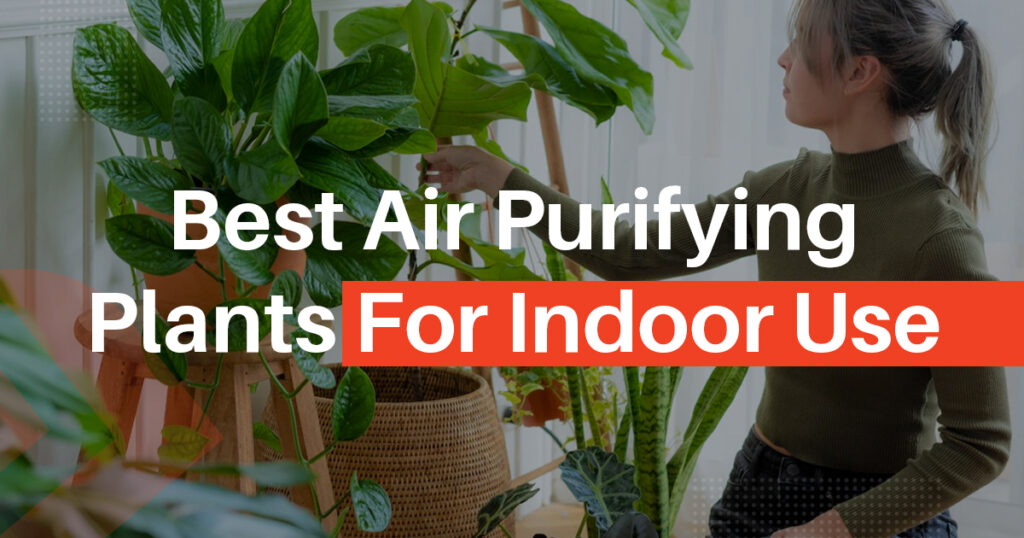All filters are made in the USA – Order Today

House plants are more than just a way to add a pop of color and nature to your home; you can even find options to purify the air in your home. With only a bit of upkeep and no additions to your electricity bill, these plants can make your indoor air quality fresher and cleaner.
In their Clean Air study, NASA suggests using certain indoor plants to eliminate airborne toxins, chemicals, germs, and dust from your home. This can be especially helpful for homeowners with asthma or other respiratory diseases.
Since there’s an endless list of air-purifying plants, knowing which one fits your home can be tricky. So keep reading to learn about the top 17 air-purifying plants for indoor use to help you make a wiser purchase.
The English Ivy is a classic and elegant plant that works perfectly as a groundcover or houseplant. Aside from purifying the indoor air of harmful chemicals, it’s also relatively low maintenance.
Whether it’s full shade or full sun, the English Ivy perseveres and can even last several years. You can also train this plant into your desired shape with the right care.
The Chinese Evergreen is a low-maintenance houseplant that can thrive in low or medium sunlight. With proper care, it grows up to two feet. Unfortunately, although the Chinese Evergreen can help maintain clean air quality, it can also be toxic to pets since it contains certain irritants.
The Dragon Tree has a head-turning appearance, with leaves ranging from purple to green. If you’re hoping to purify the air in your office, this is the perfect pick, as it thrives in low-light conditions. They’re great at removing toxins, such as xylene and formaldehyde.
When other flowers are past their prime in the fall, the Pot Mum comes to the rescue with its beautiful color palette and ability to remove toxins. Plus, these flowers are great at removing benzene and ammonia from your air.
Spider Plants are undoubtedly one of the easiest plants to take care of, as they can thrive in any condition. Whether it’s indirect light or bright direct light, these plants will thrive, but make sure not to grow them in soggy soil.
Most importantly, Spider plants are great at removing benzene, formaldehyde, and other harmful pollutants.
Rubber Trees clarify the air by breaking down and absorbing the harmful chemicals regulating your air. Additionally, their large and glossy leaves absorb our carbon dioxide to produce more oxygen.
Remember to grow them in regularly-watered and well-drained potting soil with liquid fertilizer at active growing stages.
In NASA’s Clean Air study, they emphasized Pothos’ ability to reduce xylene, carbon monoxide, toluene, formaldehyde, and benzene from the air. These plants thrive in low light and look best in hanging baskets to let their vines trail down.
Parlor Palms became popular in the Victorian Era and remain widely loved today due to their ability to thrive in the average household light conditions. In NASA’s Clean Air study, experts detailed that these plants reduce trichloroethylene and benzene from the air.
The Broad Lady Palm is the ideal option for you if you use indoor cleaning products with ammonia, which can be harmful to inhale. Additionally, this plant is also good at eliminating toluene, xylene, formaldehyde, nitrogen oxide, and benzene.
The best part is that these plants can grow in low light conditions up to six feet tall, especially in well-drained, moist soil.
In their Clean Air study, NASA discovered that Ficus Trees could remove pollutants such as xylene and formaldehyde and improve air quality in your home. However, they are somewhat high maintenance, so you mustn’t change their location or watering schedule.
The Bamboo Palm is another relatively low-maintenance air-purifying indoor plant. Also known as a Reed Palm, this plant can grow in shade or plant and gets rid of formaldehyde, benzene, and other harmful elements.
Gerbera Daisy is a popular annual plant that’s good at removing benzene from the air and enhancing the room’s mood. If you live in a hotter climate, these plants are the best pick for you as they thrive at 75 degrees or higher.
The Mother-in-Law’s Tongue plant is a hardy succulent, which is why it’s perfectly low-maintenance for beginners. Regardless of the temperatures or lighting conditions, this plant will thrive in your home and get rid of harmful toxins in the air.
Peace Lilies are relatively easy to look after, but they work hard to get rid of carbon monoxide, formaldehyde, and other toxic gasses in your home. However, it’s worth noting that they can be somewhat toxic to pets and even humans, so just remember to wash your hands after touching them.
The Corn Plant has been proven to reduce formaldehyde levels in the air, which is why it’s most commonly used to purify indoor air. Its foliage can range from yellow to green, so you can find a variation that fits your home’s aesthetics.
Lemon Button Ferns clean the indoor air by getting rid of harmful toxins. With proper care, they can grow up to a foot and thrive in indirect sunlight and humidity. If you live in a relatively dry area, it’s worth noting that these plants are more drought-tolerant than other options on our list.
The Philodendron is a beautiful plant available in multiple sizes and colors, so you can easily find one that suits you best. They thrive in bright and indirect sunlight, and looking after them is relatively easy. According to NASA’s research, they can get rid of formaldehyde, which may enter indoor air with the help of cleaning products.
Now that you know the purifying benefits of certain indoor plants, you can make the right purchase and improve the air quality in your home without paying any extra bills!
Have any questions? We’re here and ready to help!
© 2022 Custom Filters Direct. All rights reserved.